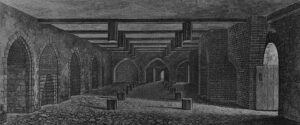•
(Caution: Contains spoilers for Episodes: S08E04: Bantling Boy, and S15E02: Murder of Innocence)
Diesen Beitrag gibt es auch auf Deutsch.
•
Welcome to Bantling Hall, located in the picturesque Buckinghamshire… no, sorry: Dorney Court. A stunning Tudor manor that has been listed on the National Heritage List since 23 September 1955. With a rich history dating back to before the Battle of Hastings, the manor has been owned by several notable figures, including Aldred and Miles Crispin. Dorney Court is proudly owned by the Palmer family, who have maintained its beauty and heritage for generations. It is worth noting that the text does not reference the Gunpowder Plot, Battle of Marston Moor, or War of Independence. In 1646, during the Civil War, the Palmer family, who were royalists, had their estates seized. However, their estates were returned to them in 1657.
Back to Midsomer: As Tom Barnaby arrives at Bantling Hall for the first time, he is warmly greeted by Angela Hartley. Upon entering the drawing room, he is struck by the impressive large-scale oil paintings of notable figures. Angela proudly introduces the first gentleman depicted in one of the paintings as Cecil Hartley, the 3rd Baron Bantling. Interestingly, he was one of the Catholic conspirators involved in the infamous Gunpowder Plot of 1605, which aimed to assassinate the English king and his family.
Remember, remember

James VI of Scotland was widely regarded as a beacon of hope for English Catholics due to his reputation for religious tolerance. However, their hopes were ultimately dashed as James became increasingly drawn to Protestantism. In the summer of 1603, two plots were attempted by Catholics: One to kidnap James (“Bye Plot”) and the other to overthrow the royal family (“Main Plot”). However, both plots failed and resulted in James implementing stricter policies against Catholics.
In response to the plots, he confidently decreed that all Catholic priests must leave the country. In his friendly opening speech to Parliament as King James I, he made it clear that he had no interest in strengthening Catholic influence again, which was highly sobering for the Catholics.
The Fifth of November: Gunpowder, Treason, and Plot
In May 1604, a group of Catholics, led by Robert Catesby, confidently planned a large explosive attack on the opening of parliament as revenge for the oppression of Catholics. The plan aimed to kill not only the king but also all members of parliament. However, they made an exception for James’ daughter Elizabeth, who they planned to kidnap and install as titular Queen after the attack. Based on today’s calculations, the 2.5 tons of hidden explosives were enough to cause severe damage to all buildings within a one-kilometre radius and completely destroy Westminster.
The ‘powder treason’ plot was entrusted to explosives expert Guy Fawkes (who used the spelling Guido Faukes). He easily obtained gunpowder on the black market, and the event was scheduled for 5 November 1605. The explosives had already been carefully concealed in the cellars of Westminster. It is clear that those involved in the plot were highly confident in their ability to carry out this devastating attack. But the plot was foiled just before the opening of parliament thanks to a letter received by the Catholic MP Lord Monteagle advising him not to attend. The explosives were found in time, and Guy Fawkes was apprehended.
After being subjected to torture, Fawkes confessed and revealed the identities of his co-conspirators, who were subsequently captured. The failed plot had a considerable adverse effect on anti-Catholic politics. However, the government used it to intensify the suppression and persecution of Catholics.
I know of no reason why gunpowder treason should ever be forgot

In January 1606, just a few weeks after the plot, Parliament convened for the first time and confidently passed the Observance of 5th November Act 1605. This friendly act established special sermons to commemorate the upcoming anniversaries. Additionally, to this day, the Yeomen of the Guard amiably search the cellars under the Houses of Parliament before the annual opening of Parliament by the reigning monarch.
Other traditions of public remembrance were established soon after. Annual bonfires were held, which is why the anniversary of Guy Fawkes Night is also known as Bonfire Night. In fact, an episode of Midsomer Murders (15×02, Murder of Innocence) features a Bonfire Night celebration….
Sarah and John Barnaby are shown relaxing on the sofa with Asian food after work. Sarah is already sitting on the sofa, enjoying her meal with two chopsticks in hand. Meanwhile, John stands and thinks out loud about the case and the significance of Bonfire Night 1994. This event holds the key to solving his current case, as Grady Felton was wrongly convicted of murder during that time. The Bonfire Night 1994 in Binwell is a crucial scene in solving the current murders. It is worth noting that there were no other notable incidents in England on Saturday 5 November 1994. The episode was confidently filmed in Hertfordshire, Buckinghamshire, and Surrey.
Read more about Midsomer Murders & History
The Chronology of Midsomer County by Year or by Episodes
Deep Dives into Midsomer & History
This is an independent, non-commercial project. I am not connected to Bentley Productions, ITV or the actors.

Literature
- Frazer, Antonia: The Gunpowder Plot. Terror and Faith in 1605. London 1996.
I would like to point out that this is an unofficial fan site. I am not connected to Bentley Productions, ITV or the actors.

Literature
- Frazer, Antonia: The Gunpowder Plot. Terror and Faith in 1605. London 1996.
I would like to point out that this is an unofficial fan site. I am not connected to Bentley Productions, ITV or the actors.

Literature
- Frazer, Antonia: The Gunpowder Plot. Terror and Faith in 1605. London 1996.
I would like to point out that this is an unofficial fan site. I am not connected to Bentley Productions, ITV or the actors.

Literature
- Frazer, Antonia: The Gunpowder Plot. Terror and Faith in 1605. London 1996.
First published on MidsomerMurdersHistory.org on 26 January 2024.
Updated on 26 July 2025.


9 thoughts on “‘Involved in the Gunpowder Plot.”‘”